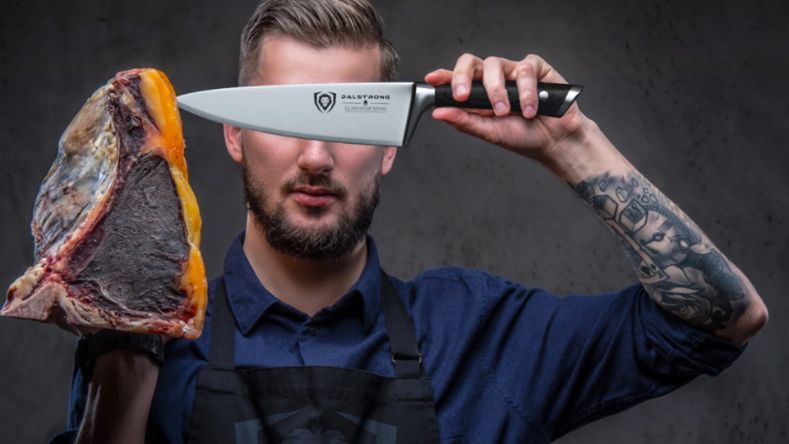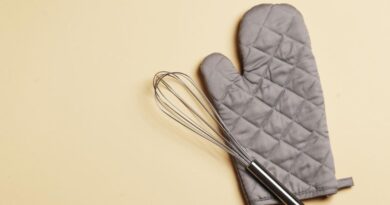Is Dalstrong a reputable company to buy knives from if you’re in the market for kitchen knives? In this article, I provide an authoritative and impartial response to that issue based on my extensive testing of them. In this in-depth evaluation of Dalstrong knives, you’ll discover all you need to know about the Dalstrong knife set and its collection.
Dalstrong knives represent an enticing option for those seeking quality blades at affordable prices. Established in 2014, the company has swiftly made its mark in the knife industry, aiming to compete with high-end German and Japanese brands. Crafted with precision and innovative design, these knives offer a range of cutting-edge features.
Dalstrong knives boast a striking hammered blade design that prevents food from sticking during use, showcasing the company’s dedication to both functionality and aesthetics. The knives come in various styles, with Japanese-inspired blades offering sharper angles and German-style knives featuring slightly broader angles, catering to different cutting preferences.
Read Also: What is a Heavy Bottom Saucepan: Best Options To Choose
Company Details
Company Background
- Founded in Canada in 2014 by CEO David Dallaire, Dalstrong is a newer player in the knife industry dominated by established brands like Wusthof, Zwilling, and Global.
- David Dallaire personally designs every Dalstrong collection, infusing them with creativity and vision.
Mission and Approach
- Dalstrong’s mission revolves around creating visually appealing and reliable knives at reasonable prices.
- Their designs draw inspiration from various sources such as cultures, art, nature, and even infrastructure, resulting in eye-catching and bold knife designs.
Innovation and Product Range
- Known for being forward-thinking, Dalstrong constantly introduces new products.
- Presently offering 11 kitchen knife sets, the company is expected to expand its product line further in the near future.
Availability and Sales Channels
- Dalstrong knives are predominantly available for purchase on Amazon and through their official website, Dalstrong.com.
- In addition to kitchen knives, the company also offers knife accessories, kitchenware, and stainless-clad cookware, although kitchen knives remain their primary product.
Expansion and Future Plans
- While currently having a limited number of collections available, Dalstrong intends to introduce more collections in the future, broadening their product range.
Where They Are Manufactured
Dalstrong manufactures its knives at a plant in Yangjiang, China, a place with a long and illustrious history in the art of knife making that dates back more than 1400 years.
As a result, well-established German and Japanese knife companies no longer produce their items in Germany or Japan. Dalstrong, on the other hand, seems to take delight in doing things differently.
The corporation has administrative offices and warehouses in the United States, Canada, the United Kingdom, and, eventually, the Netherlands, among other locations worldwide.
Construction and Material
The most common concern I hear from home cooks about knives made in China is that the quality varies from one knife to another.
And many firms indeed choose the minor production costs, which results in lower-quality knives in many cases. Dalstrong, on the other hand, is not like that.
Let’s look at the materials that Dalstrong uses and the techniques it uses to create its blades.
Blades
Steel Quality
- Dalstrong uses high-quality German and Japanese steel for their blades.
- The specific steel varies among collections but generally falls within the mid-to high-tier range, superior to cheaper, mass-produced knives from China.
- For instance, the Gladiator series employs ThyssenKrupp German steel, similar to renowned manufacturer Wusthof’s blades.
- The Shogun series utilizes high-quality Japanese steel (AUS-10V), known for its strength and edge retention comparable to top Japanese knife producers like Shun and Miyabi.
Handles
Dalstrong employs a variety of materials for the handles in each of his lines. Here’s a quick look at what’s going on:
ABS Polymer
ABS Polymer is a very durable, sleek, food-grade plastic that is sanitary and resistant to heat, cold, and moisture. ABS Polymer is also extremely lightweight. It may be seen in the Shogun series.
G10 Garolite
In the case of G10 Garolite, a composite material created under tremendous pressure, results in a highly robust, military-grade handle that can withstand extreme temperatures. It excellently repels water, preventing moisture-related problems such as mildew and rust. It may be found in the Gladiator, Shadow Black, Omega, Quantum 1, and Delta Wolf series collections, among other places.
PakkaWood
Imported from Spain, this beautiful, rich laminated wood is used to create visually attractive and long-lasting handles. It is a hygienic material that is ideal for use in busy kitchens. It can be seen in the Phantom series.
Rosewood
A beautiful redwood used as an accent on G10 handles, rosewood is a popular choice. It’s a dense, long-lasting wood with a deep, rich hue. It may be seen in the Ronin series.
Stainless Steel
A high chromium concentration in stainless steel helps to prevent corrosion, and there is no cleaner material than stainless steel. These non-porous handles have no gaps or crevices where material may collect. It may be seen on the Crusader television series.
Resin/ Wood
A mixture of wide-grained wood and blue mosaic resin is used in this piece. It’s a heat- and cold-resistant combination that can survive extremes in temperature. It may be seen on the Valhalla television series.
Resin/Aluminum
This striking mix of sealed resin and aluminum mesh is sure to capture the eye. Like the majority of Dalstrong handles, it is resistant to heat, cold, and moisture. It may be found in the Frost Fire series.
Each Dalstrong series has a distinct appearance based on the materials and quality of the Blade and handles.
Read Also: Misen Carbon Steel Pan Review: History And Characteristics
Performance
- Competitive Positioning:
- Dalstrong aims to rival high-end German and Japanese blades with their knives, emphasizing quality in design and manufacture.
- Quality and Comparison:
- While Dalstrong knives are of high quality and offer good value for money, they might not match the prestige of more established brands like Wusthof or Shun, which are pricier.
- They excel in cutting through ingredients and feature a hammered blade design that prevents food from sticking together.
- Shortcomings in Comparison:
- Compared to renowned competitors, Dalstrong knives often lack balance, feeling blade-heavy. While visually appealing, the handles have a lighter feel.
- Lightweight handles offer agility but might require more effort when cutting dense materials, potentially causing hand fatigue due to the need for more pressure rather than relying on the knife’s weight.
- Variations in Sharpness and Hardness:
- Dalstrong knives feature different sharpness levels, with Japanese-style knives typically having sharper angles (8-12 degrees) compared to German-style knives (16-18 degrees).
- The hardness of the blades varies across collections, ranging from 55 to 63 on the Rockwell Scale. Higher numbers indicate tougher steel, retaining sharpness longer but making blades more brittle and prone to chipping.
- Observations on Specific Series:
- In the Gladiator series, the full tang design, while adding weight, might obstruct a comfortable pinch grip, affecting handling.
- Dalstrong claims complete tangs for their knives, demonstrated by a “ding” sound and a hollow feel in the handle when touched, indicative of the construction.
These points highlight the strengths and areas for improvement in Dalstrong knives, discussing aspects of balance, handle feel, sharpness variations, hardness levels, and specific observations on certain series like Gladiator regarding handling and tang construction.
Drawbacks
Dalstrong knives have a lot to offer in terms of design and functionality. However, it is essential to be aware of the drawbacks before purchasing.
Dalstrong is a very young and untested brand that is still in its infancy. There has just not been enough time to put it through its paces.
Hardness of the Blade
Some Dalstrong blades, like Omega and Shogun, may have too high a Rockwell score, making them too hard and prone to chipping. Alternatively, a specific criticism concerning softer steel knives, such as those in the Gladiator series, is that the edges get dull much too soon. Choose softer steel (lower Rockwell score) if you want to chop with your knives; yet, hard steel is appropriate if you need ultra-sharp blades for precision cutting.
Handles that are out of the ordinary
Many of Dalstrong’s unconventionally shaped handles, as intriguing as they are to look at, aren’t the most pleasant to hold. The handles feature a geometric design with sharp edges that give the blades an unpleasant sensation in hand when it comes to the Shadow Black line of knives.
Design with a full bolster
Even while the complete bolster on the Gladiator series provides weight and balance to the knife, it prohibits the whole Blade from being sharpened. As a result, it also interferes with the ability to conduct a pinch grasp.
Balance
However, despite the knives being forged and having a full tang, they don’t feel as strong and balanced as many other forged and full-tang knives that I have tried and evaluated.
Origin
For some, knives produced in China may be a source of contention, and Dalstrong is well aware of this. It is for this reason that the firm takes the time to explain the rich knife-making history of the area and how the factory in Yangjiang stands head and shoulders above all others due to their high standards and methods.
They also introduce the crafters, telling us about their profession and the years of experience that they have had.
Conclusion
Dalstrong knives present a compelling option for those seeking high-quality knives at reasonable prices. With a focus on design, innovation, and competitive positioning against high-end German and Japanese blades, Dalstrong offers a range of knives that excel in cutting performance and value for money. However, while they boast impressive qualities like a hammered blade design and various sharpness levels, they may fall short in terms of balance and handle weight when compared to more established brands. Understanding the nuances of their sharpness, hardness variations, and specific series designs helps in making an informed choice about these knives.
FAQs
While Dalstrong knives offer good value for money and cutting performance, they might lack the prestige and balance found in more established brands. They excel in certain aspects but might not match the overall quality and feel of renowned brands.
Dalstrong knives feature a hammered blade design that prevents food from sticking together, varying sharpness levels based on knife styles (Japanese or German), and differing hardness levels across collections for edge retention.
The lightweight handle design might make it more challenging to cut dense materials as more pressure may be required compared to heavier knives that rely on their weight.
Sharpness varies based on the knife style, with Japanese-style knives having sharper angles. Hardness, measured on the Rockwell Scale, affects edge retention but can also impact the blade’s brittleness and susceptibility to chipping.
The full tang design in the Gladiator series might add weight to the knives and could potentially interfere with a comfortable pinch grip, affecting handling and balance during use.







